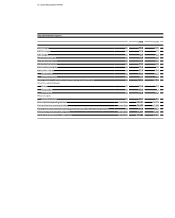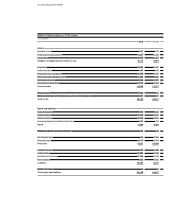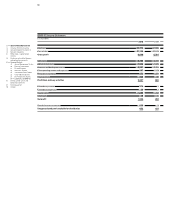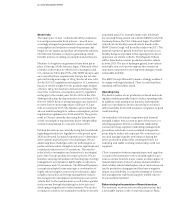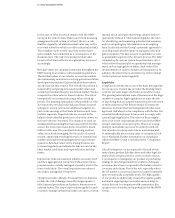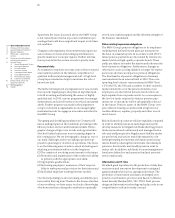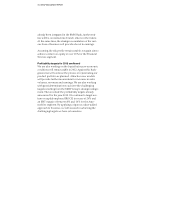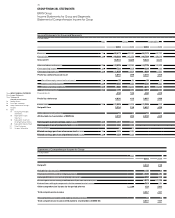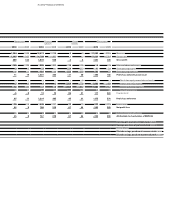BMW 2010 Annual Report Download - page 68
Download and view the complete annual report
Please find page 68 of the 2010 BMW annual report below. You can navigate through the pages in the report by either clicking on the pages listed below, or by using the keyword search tool below to find specific information within the annual report.
66
12 GROUP MANAGEMENT REPORT
12 A Review of the Financial Year
14 General Economic Environment
18 Review of Operations
41 BMW Group – Capital Market
Activities
44 Disclosures relevant for takeovers
and explanatory comments
47 Financial Analysis
47 Internal Management System
49 Earnings Performance
51 Financial Position
53 Net Assets Position
55 Subsequent Events Report
55 Value Added Statement
57 Key Performance Figures
58 Comments on BMW AG
62 Internal Control System and
explanatory comments
63 Risk Management
70 Outlook
are identified, measured, monitored, evaluated and
managed in the BMW Group on the basis of recognised
standards and regulations that generally apply world-
wide in this line of business. Risk management is based
on concepts, methods and procedures developed and
continuously being updated within the regulated bank-
ing sector, e.g. the “Minimum Requirements for Risk
Management” (MaRisk) applicable in Germany.
The main categories of risk relating to the provision of
financial services are credit and counterparty risk, residual
value risk, interest rate risk, liquidity risk and operating
risks. We have developed internal methodologies and
techniques that comply with national and international
standards and regulatory requirements such as BaselII to
measure credit, residual value and interest rate risks on
the one hand and operational risks on the other. Internal
guidelines are also in place to manage liquidity risk and
ensure compliance with regulatory requirements.
Credit risks arise in conjunction with lending to retail
customers
(leasing, credit financing) and commercial
customers
(dealers, fleet customers, importers). Counter-
party risks arise on financial transactions with banks and
financial institutions entered into to refinance business
and manage risk. Advanced scoring and rating models
are employed to assess customers’ creditworthiness as
part of the risk management process for lending. Lending
is based on a conservative evaluation of col lateral
(nor-
mally the financed vehicle or object).
The recoverability of the value of collateral is continu-
ously checked and measured in order to assess the level
of unsecured risks. Stress tests and back-testing proce-
dures ensure that the measurement of our portfolios is
up to date. Modern credit-value-at-risk methods, incorpo-
rating binding and fixed limits for credit risks, are used
for measurement purposes. These limits are regularly
reviewed every quarter. In order to minimise risk, we em-
ploy typical banking instruments such as retrospective
collateral, multiple collateral, retention of vehicle docu-
ments and higher upfront payments.
In addition, close and regular contact with borrowers, a
good understanding of the leased or financed vehicles
involved (including subsequent disposal of the asset)
and prudent measurement of collateral all help to mini-
mise risk substantially. Lending based on typical bank-
ing sector criteria and guidelines together with principles
derived from MaRisk, such as segregation of duties be-
tween front-office and back-office functions, dual control
at all stages of the credit decision, risk-based upfront
payments and mandatory authorisation matrices, are
integral components of the Group’s risk-based credit
processes.
All process steps, such as segregation of duties, or the use
of techniques to recognise risks at an early stage, are
required to be applied worldwide. Appropriate testing is
carried out to ensure that the systems are up to date and
working properly. Local, regional and centralised credit
audits are regularly performed to test compliance with
lending guidelines applicable throughout the Group, credit
processes and the underlying IT systems.
We continue to develop standardised credit decision
processes for the BMW Group worldwide and are con-
stantly endeavouring to improve the quality of credit
applications, the Group’s rating methodology and
pro-
cedures used to select employees within the worldwide
counterparty risk network.
Risk criteria with worldwide applicability, such as retail
customer arrears, bad debt ratios, the expense for allo-
cations to bad debt allowances and the proportion of
dealer financing volumes subject to problems are calcu-
lated and analysed on a monthly or quarterly basis and
used in the context of proactive risk management. This
information is provided to local, regional and centralised
management along with appropriate recommendations
for action as the basis for decision-making. The measures
taken enabled us to present, measure and manage credit
risk more transparently in 2010 and to reduce its level
accordingly. The provision for credit risks in the field of
dealer financing was raised in 2010 as a consequence of
the delayed effect of the financial crisis. This field is only
likely to return to anywhere near normal levels after a
delay of one to three years.
All credit risk decisions relating to international dealers,
importers and fleet customers are made in a three-stage
credit decision process. Alongside the total credit amount
(before and after deduction of collateral), the credit rat-
ing
allocated and the requirement to comply with stipu-
lated credit risk guidelines provide the basis for this
process.
The final decision is made by the national
, re-
gional or global credit committee, and the back-office
input to the relevant committees cannot be overruled.
Specific and general allowances are recognised at the ap-
propriate amounts to cover identified risks.



